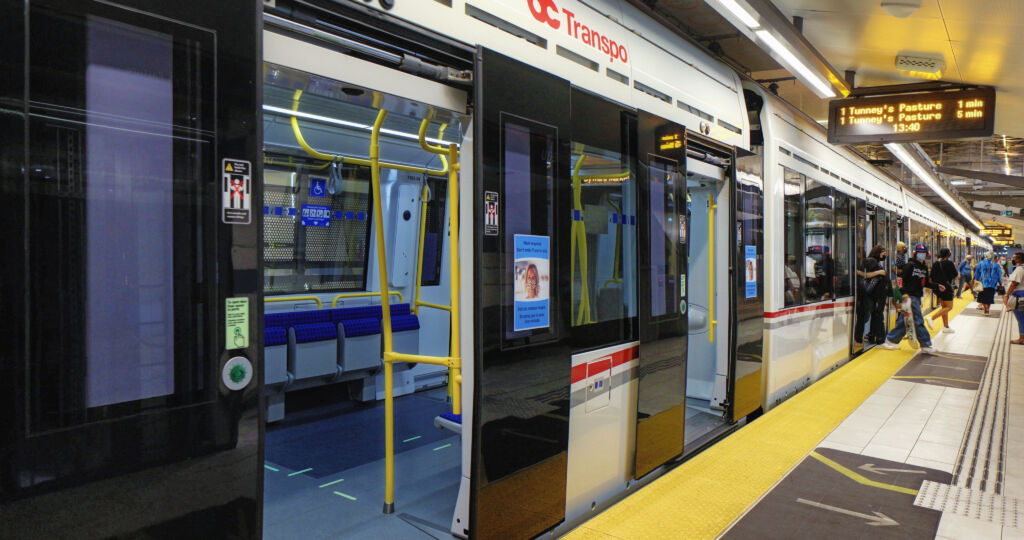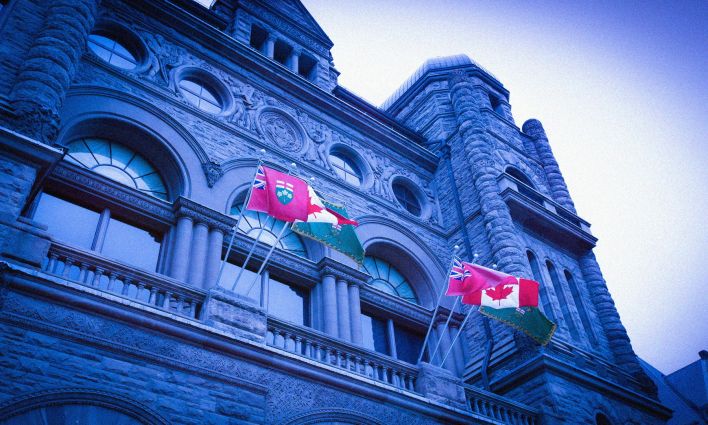I remember the excitement I felt when Ottawa’s long-awaited light rail train finally opened to the public. This new train promised to shorten my long daily commute, and when it worked, it was wonderful. But soon, my commute, like many Ottawa residents’, suffered from frequent delays and being forced to ride crowded buses, even in a pandemic. Why did this happen, and what does this mean for the future of Ottawa’s transit?
A brief history
In 2012, the City of Ottawa awarded Rideau Transit Group (RTG) a $2.1 billion contract to build a new light rail transit (LRT) system in the capital as a public-private partner-ship (P3) project. Unfortunately, although it was scheduled to be completed in 2017, the train system wouldn’t open to the public until September 2019. The construction process faced many obstacles, including a sinkhole and trains unable to withstand the city’s harsh winters. Despite these shortfalls, in 2019, the City awarded RTG a second contract, worth $4.66 billion, to extend the light rail system.
This was only the beginning of the turmoil that would plague this project. Shortly after the LRT opened to the public, it frequently became delayed, generally due to maintenance issues. Unfortunately, things continued to get worse,
and in September 2021, the line was shut down for 54 days after two derailments within a six-week period. This led to outrage from many riders demanding an explanation for both the unsafe conditions of the derailments and the extended service disruptions that followed.
The politics behind it
In November 2021, the Transportation Safety Board of Canada determined that one of the derailments was caused by poor maintenance of the trains. Following this report, the ATU 279, Ottawa’s transit union, issued a statement blaming, “the city’s continued use of public-private partnerships that place profit ahead of safety.” Sam Hersh, a Board Member at Horizon Ottawa, also believes that the P3 model is at the core of the LRT’s issues. “The City tried to get the cheapest deal that they could and rush it as fast as they could for political expediency, and private partners want to cut corners [by] doing the cheapest way that they were able to. They don’t really have the public interest in mind,” he explains.
Additionally, there is controversy concerning the organization selected to undertake the LRT project. Rideau Transit Group is a consortium of companies that includes SNC Lavalin, the Montreal-based engineering firm that became a household name after its involvement in an infamous bribery scandal involving the federal government. Previously classified documents released by the City revealed that SNC Lavalin’s component of the second stage bid failed to meet the required technical score evaluated by experts twice. However, city executives were advised not to disqualify the firm from the bidding process by their lawyers from Norton Rose Fulbright, a firm that has previously represented SNC Lavalin. Despite failing to meet the technical threshold, SNC Lavalin’s bid had an advantage over its competitors as it was significantly cheaper, leading it to be chosen. Mayor Jim Watson and city manager Steve Kanellakos have defended this choice, claiming that it to be “good value for taxpayers.” And so, TransitNEXT, a wholly owned subsidiary of SNC-Lavalin, was awarded the $1.6 billion contract to extend Ottawa’s north-south Trillium Line.
Finally, one of the most concern-ing aspects of this debacle is the lack of transparency on the part of the mayor and the city executives. Watson resisted a judicial inquiry proposed by councillor Catherine McKenney, and instead supported a municipal audit proposed by another councillor. Unlike the judicial inquiry, an audit would have no public hearings and the auditor general wouldn’t be able to investigate the mayor or council members. During one heated debate, Watson muted fellow councillor Diane Deans when she challenged him over the audit. Nevertheless, the province decided to launch a public inquiry into September’s derailment in November 2021. The province’s inquiry has more power than the investigation conducted by the city, but does not have the scope of a judicial inquiry. Depending on the results of the investigation, Premier Doug Ford has said he may withhold funding for the LRT’s Stage 2 construction. The province has already withheld $60 million of Stage 1 funding.
Taxpayers deserve to know where their money is going, and Ottawa residents deserve to know why their transit system has struggled (and failed) to provide reliable service.
Building a better future
There are many lessons that can be learned from this debacle. According to Hersh, this should be an indictment of P3s for maintaining city infrastructure. He says that, “ideally, what we want to see is more public ownership of our municipal infrastructure.” In the ATU 279’s statement, president Clint Crabtree shared this sentiment, saying, “there is no reason why any of this work could not have been done in-house where we have actual trained, unionized maintenance workers. Not doing so is putting people’s lives at risk.” The union calls the lack of transparency surrounding this project “typical of P3 projects.”
A better transit system would require more transparency towards the public and City Council when it comes to its infrastructure projects. Taxpayers deserve to know where their money is going, and Ottawa residents deserve to know why their transit system has struggled (and failed) to provide reliable service. When voting on expansions, investments and improvements, city councillors should have access to all of this historical information.
One of the key components of a better transit system is accessibility, starting with universally free transit. Hersh says that instead of relying on farebox revenue, transport should rely solely on public funding. “There’s going to be people who are taking transit regardless of if there’s high ridership, because it’s a public asset.” He adds that going fare-free would, “make it safer for transit workers, too, because the vast majority of assaults that happen to drivers in the transit system are because of fare disputes.” Kari Elliott, Board Member of Ottawa Transit Riders, agrees that, “it’s completely and utterly ridiculous to keep raising the transit fares on our transit system that is in decline. It really hurts low-income people… and it hurts people who rely on transit.” Raising fares as a means of solving a transit funding crisis is a solution that is as myopic as it is inequitable.
Elliott also emphasizes the importance of making transit accessible to disabled people, the subject of Ottawa Transit Riders’ ParaParity campaign. Although the buses and the LRT are designed to be fairly accessible to wheelchair users, getting to the system is more challenging. “A lot of the members of our group say they can ride regular transit during the summer, but in the winter, when the snow comes, they’re having to go to Para-Transpo.” Para-Transpo, a city service for people unable to take conventional transit, has limited resources and capacity which makes it difficult to meet the needs of their riders. Users need to book the service in advance, which isn’t helpful if they want to take spontaneous trips, and the bookings must be done by phone—and it can take hours to get through. Simple changes such as better snow clearing and an online booking system could make a world of difference.
Disabled people should have the opportunity to communicate their needs and be listened to, but Elliott says that Para-Transpo is often left off the agenda of the Transit Commission’s monthly meetings, which prevents the issue from being discussed.
Good transit also needs to be reliable, which is difficult when the city doesn’t have enough buses to cover all its routes—especially when the train breaks down. This results in cuts, primarily to neighbourhood routes. Elliott says that there’s a lack of communication from OC Transpo about buses being delayed or cancelled, and wants to see more accurate messaging. “They have to stop pretending that if they don’t tell us it doesn’t actually happen.”
Finally, a good transit system should be in touch with its riders. Much of the transit in Ottawa is currently de-signed around commuters from the suburbs who work downtown, even though many of those people now work remotely and the most recent Census data shows that Ottawa workers commute journeys are changing, with more workers commuting between suburbs, and doing “reverse commutes” from the downtown core to the outer city. “These are people who are working and commuting, but they may not be [travelling from] suburban to downtown.” says Elliott. “So we really need to have a complete look at which routes are really important to the people who are right now using them.”
After years of delays and derailments, it’s important not to forget the vital role that quality transit can play in people’s lives and communities at large. “A lot of people argue that we have to choose between being free and being reliable, but we know we don’t have to,” says Hersh. “We can have a free and reliable system.” Having a free, reliable transit system designed based on its riders’ needs would improve the quality of life in the city by saving people money, reducing cars on the road, connecting communities and making travel within the city more accessible.
“Public transit [is] opening the door to making the city really accessible to low-income people,” says Elliott.
The LRT scandal has shown us what we don’t want in a public transit system. With the first major change in leadership in over 10 years, the time is ripe for Ottawa residents to demand the transit system we deserve.








